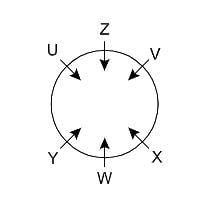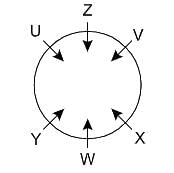NVS TGT Science Mock Test - 6 - NVS TGT/PGT MCQ
30 Questions MCQ Test - NVS TGT Science Mock Test - 6
Directions: Each of the following consists of a question and two statements numbered I and II given below it. You have to decide whether the data provided in the statements are sufficient to answer the question.
Six persons from U to Z are sitting around a circular table and facing towards the centre such that Y is second to the right of Z, who is third to the left of W. Z is on the immediate right of V. Who sits second to the right of U?
Statement I: X is not adjacent to Z.
Statement II: Y is the second to the left of X.
Statement I: X is not adjacent to Z.
Statement II: Y is the second to the left of X.
Direction: Study the following question carefully and choose the right answer.
If in a code language, PAINT is written as 74128 and EXCEL is written as 93596, then how will ACCEPT be written in that language?
IEEE 802.3ab defines Gigabit Ethernet transmission over unshielded twisted pair (UTP) category 5, 5e or 6 cabling known as ______.
A laser printer
(i) prints an entire line at a time
(ii) is a non-impact printer
(iii) allows multiple copies to be taken at a time
(iv) prints one character at a time
A heavy cylinder of length 1 is slowly taken out of a dense liquid. The weight felt as it is taken out of the liquid
Two light bulbs P and Q are identical in all respects, except that P’s filament is thicker than Q’s. If the same potential difference is applied to each, then
Ms. Anjali wanted to introduce the 'water cycle' by asking students to first conduct an activity at home and then relating that to the concept.
Which of the following activities will be MOST suitable for the purpose?
The sound waves which travel in the air are called:
A person with defective eyesight is unable to see objects clearly nearer than 1.5 m. He wants to read a book placed at a distance of 30 cm from his eyes. The type of a required lens and its focal length is
Which of the following is the INCORRECT method of preventing rusting?
Which one of the following decreases the extent of evaporation of water?
The conversion of butene to butane in presence of nickel is an example of:
If a solution contains 60g of common salt in 340g of water, the mass by mass percentage will be:
In a hydroelectric power plant more electrical power can be generated if water falls from a greater height because:
Which of the following do not cause disease in plants?
Instead of limiting classroom learning to textbooks, National Education Policy 2020 suggests that learning and education should be-
Which of the following is an example of genetic variation ?
The enzymes pepsin and trypsin are secreted respectively by
Choose the correct option to mark the synonym of the words given in the question.
Diatribe
रमेश सरकारी नौकरी के लिए इधर उधर..................... रहा हैं। उपयुक्त मुहावरे से रिक्त स्थान की पूर्ति कीजिए।
व्याकरण की दृष्टि से दिए गए वाक्य के किस भाग में अशुद्धि है?
मैं दो घंटे से आपकी प्रतीक्षा देख रहा था।
















